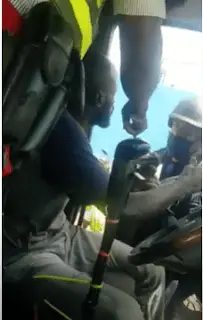The driver refuses to obey the police
Many Can Drive But Not All Are Drivers !!!

Thank you for reading this post. Don't forget to subscribe!
Checkout Our Social Media Pages HERE
Drivers continue to get into arguments with the police on our roads. Drivers, you must stop it. Comply with the orders of the police and then you go to court and argue your case in court.
Drivers you are in charge of your motor vehicles and the police officers are in charge of law and order on our streets therefore you must comply with their orders. All I would say to police officers is be courteous but firm and if we give you trouble, you might have to throw all the law books at us.
As a defensive driver, you can avoid crashes and help lower your risk behind the wheel.
If you’ve been out on the roads, you know that not everyone drives well — but most people think they do. Some drivers speed aggressively.
Others wander into another lane because they aren’t paying attention. Drivers may follow too closely, make sudden turns without signaling, or weave in and out of traffic.
Aggressive drivers have known road hazards, causing one-third of all traffic crashes. But inattentive or distracted driving is becoming more of a problem as people “multitask” by talking on the phone, texting or checking messages, eating, or even watching TV as they drive.
You can’t control the actions of other drivers. But updating your defensive driving skills can help you avoid the dangers caused by other people’s bad driving.
Skills That Put You in Control
Before you get behind the wheel of that two-ton frame of glass and steel, here are some tips to help you stay in control:
PLEASE REMEMBER TO SUBSCRIBE
Stay focused. Driving is primarily a thinking task, and you have a lot of things to think about when you’re behind the wheel: road conditions, your speed, and position observing traffic laws, signs, signals, road markings, following directions, being aware of the cars around you, checking your mirrors — the list goes on.
Staying focused on driving — and only driving — is critical to safe driving.
Distractions, like talking on the phone or eating, make a driver less able to see potential problems and properly react to them.
It’s not just teen drivers who are at fault: People who have been driving for a while can get overconfident in their
driving abilities and let their driving skills get sloppy. All drivers need to remind themselves to stay focused.
Stay alert. Being alert (not sleepy or under the influence) allows you to react quickly to potential problems — like when the driver in the car ahead slams on the brakes at the last minute.
Alcohol or drugs (including prescription and over-the-counter drugs) affect a driver’s reaction time and judgment.
REMEMBER TO SUBSCRIBE
Driving while drowsy has the same effect and is one of the leading causes of crashes. So rest up before your road trip.
Watch out for the other guy. Part of staying in control is being aware of other drivers and roadway users around you (and what they may suddenly do) so you’re less likely to be caught off guard.
For example, if a car speeds past you on the highway but there’s not much space between the car and a slow-moving truck in the same lane, it’s a pretty sure bet the driver
will try to pull into your lane directly in front of you. Anticipating what another driver might do and making the appropriate adjustment helps reduce your risk.
Eight Secrets of Super Driving
When you drive defensively, you’re aware and ready for whatever happens.
You are cautious, yet ready to take action and not put your fate in the hands of other drivers.
According to the U.S. Department of Transportation, 90% of all crashes are attributed to driver error.
Following these defensive driving tips can help reduce your risk behind the wheel:
Think safety first. Avoiding aggressive and inattentive driving tendencies yourself will put you in a stronger position to deal with other people’s bad driving.
Leave plenty of space between you and the car in front. Always lock your doors and wear your seatbelt to protect you from being thrown from the car in a crash.
Be aware of your surroundings — pay attention. Check your mirrors frequently and scan conditions 20 to 30 seconds ahead of you.
Keep your eyes moving. If a vehicle is showing signs of aggressive driving, slow down or pull over to avoid it.
If the driver is driving so dangerously that you’re worried, try to get off the roadway by turning right or taking the next exit if it’s safe to do so.
Also, keep an eye on pedestrians, bicyclists, and pets along the road.
Do not depend on other drivers.
Be considerate of others but look out for yourself.
Do not assume another driver is going to move out of the way or allow you to merge.
Assume that drivers will run through red lights or stop signs and be prepared to react.
Plan your movements anticipating the worst-case scenario.
Follow the 3- to 4-second rule. Since the greatest chance of a collision is in front of you, using the 3- to 4-second rule will help you establish and maintain a safe following distance and provide adequate time for you to brake to a stop if necessary.
But this rule only works in normal traffic under good weather conditions.
In bad weather, increase your following distance an additional second for each condition such as rain, fog, nighttime driving, or following a large truck or motorcycle.
Keep your speed down. Posted speed limits apply to ideal conditions.
REMEMBER TO SUBSCRIBE
It’s your responsibility to ensure that your speed matches the conditions.
In addition, higher speeds make controlling your vehicle that much more difficult if things go wrong.
To maintain control of your vehicle, you must control your speed.
Have an escape route.
In all driving situations, the best way to avoid potential dangers is to position your vehicle where you have the best chance of seeing and being seen.
Having an alternate path of travel also is essential, so always leave yourself an out — a place to move your vehicle if your immediate path of travel is suddenly blocked.
Separate risks.
When faced with multiple risks, it’s best to manage them one at a time. Your goal is to avoid having to deal with too many risks at the same time.
Cut out distractions.
A distraction is any activity that diverts your attention from the task of driving. Driving deserves your full attention — to stay focused on the driving task.
If you’re interested in taking a defensive driving course to help sharpen your driving knowledge and skills, contact your local AAA or your state’s Department of Motor Vehicles (DMV).
Many states keep a list of approved defensive driving course providers, and lots of these offer online programs.
In some states, you may be eligible for insurance premium discounts, “positive” safe driving points, or other benefits.
These courses do cost money, but it’s worth the investment to be a smarter, safer driver.
Safe driving!


